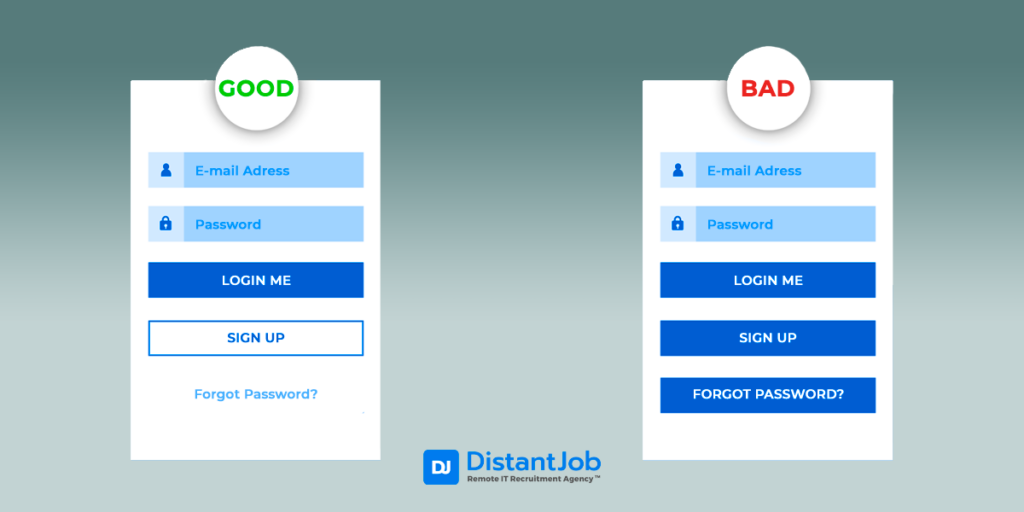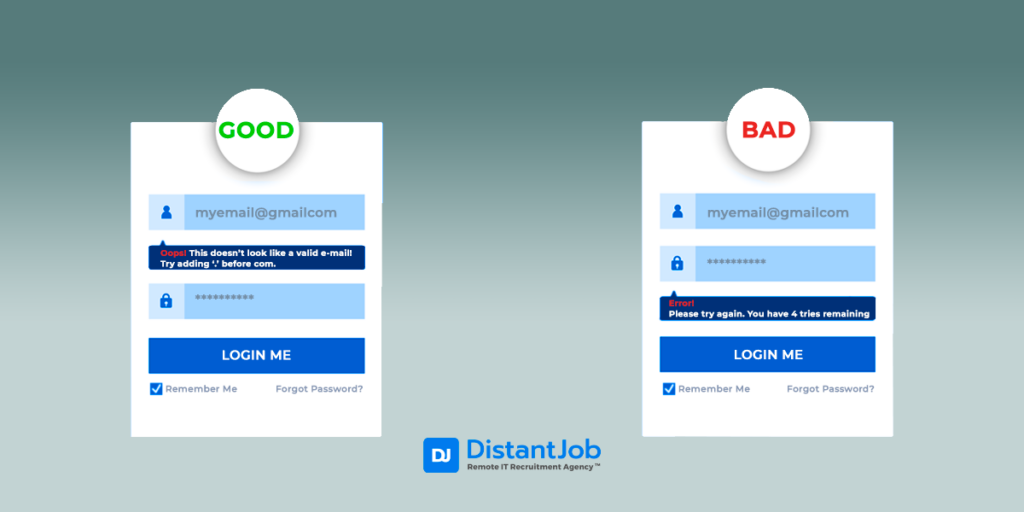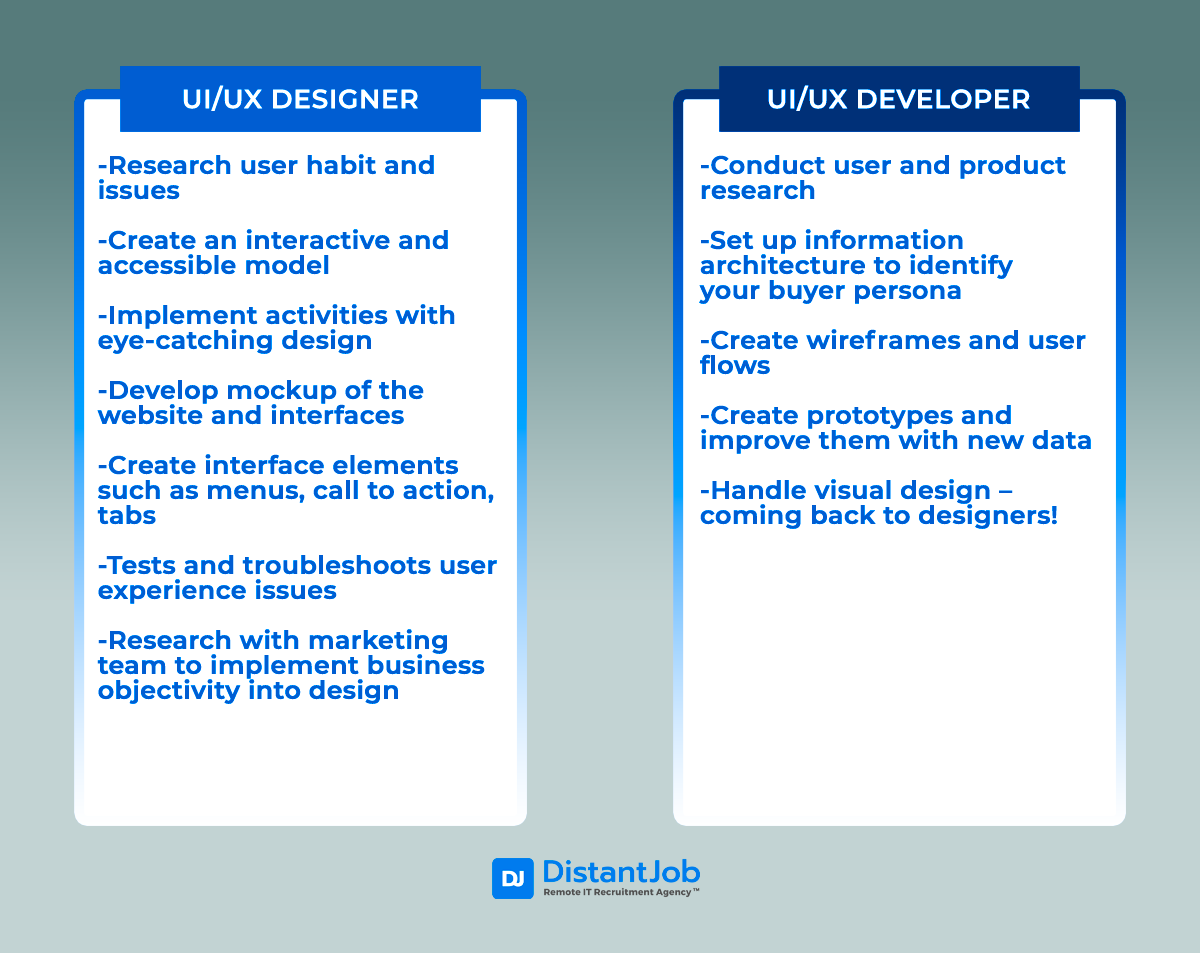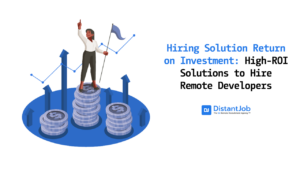Ever found yourself endlessly scrolling through a webpage, only to leave frustrated without finding what you need? On my side, the first example coming to mind is Italian government websites, where icons and buttons are merely arbitrary and counterintuitive.
When we talk about e-commerce and remote businesses, you have competition, and your online page is like your business card. If it takes me over 5 minutes to purchase an item or to subscribe, I may just look somewhere else – which for you means sending your customers to your competitors.
It’s here that the expertise of UI/UX developers and designers becomes indispensable. By improving the user interface (UI) and enriching the user experience (UX), they craft a seamless journey for your visitors, ensuring that every interaction on your webpage is intuitive and satisfying, which leads them a step closer to conversion.
In this article, we’ll dive into the differences between UI/UX developers and UI/UX designers. We’ll explore the responsibilities of UX and UI designers when it comes to creating an effective website. We will look at both good and bad examples of UX, as well as the necessary skills and qualifications required for each role. Finally, we will discuss how the two roles work together to create an effective website.
What’s the Difference Between UX and UI Design?
User Experience (UX) Design and User Interface (UI) Design are two pillars that play a crucial role in the realm of digital product development. While they share a common goal of providing a positive user experience, their approach and areas of focus differ significantly. UX Design delves into the conceptual aspects, understanding the user’s journey, and ensuring a logical flow from one step to the next. It’s about solving problems and making the interaction as efficient and straightforward as possible. On the flip side, UI Design is about the visual and interactive elements of a product’s interface. It involves designing the layout, visual aesthetics, and interactive properties to ensure not only a visually appealing experience but one that guides the user intuitively through the product.
By distinguishing between UX and UI Design, one can better appreciate the multi-faceted approach required to create user-centric digital solutions. Let’s go more in-depth with explaining the difference between the two.
User interface (UI)
The user interface is what the user sees and touches when using a digital service or purchasing a product – including screens and touchscreens, sounds, and light. Nowadays, kids play on iPads, and grandmas follow their nephews on Instagram. But it wasn’t always like that.
Do you remember the first computers in the 70s? Back then, to use a computer, you needed to know a programming language to complete the most straightforward task.
The first graphical user interface (GUI) only arrived in the 80s. For the first time, users could use a computer with buttons, icons, menus, and so on. Anyone could use a computer, and no coding was required.
In 1884, Apple Computer released the Macintosh, one of the first home computers to use simply via the interface. What follows is history.
This crucial shift in technology meant that computers were accessible to everyone. It also meant that you needed someone able to design interfaces thinking like a future user. Without an accessible interface, your product isn’t going to sell. That’s how UI designers and developers come to our story. Today, with the proliferation of digital devices and new technologies, UI design’s range of action is almost limitless.
Examples of good and bad UI

User Experience (UX)
The user experience is a consequence of the growth of UI design. After you navigate a page or use an app, you have the experience of it. As we said, that can be good or bad, depending on how the user feels about these interactions.
UX professionals work on multiple touchpoints with the user. Working closely with the marketing team, they research how your clients discovered your business, the sequence of actions they take interacting with your pages, how they feel completing this task, and their impression of the overall experience.
The goal is to ensure a product that meets customer needs and achieves the desired outcome.
Examples of good and bad UX

The Difference Between UI/UX Designer & Developer Explained
UI/UX Designers and Developers play distinct but complementary roles in creating a digital product.
In essence, while designers focus on the look and feel of a product, developers focus on making these designs functional. The collaboration between UI/UX Designers and Developers is pivotal in ensuring a product is both aesthetically pleasing and functionally robust.

Just remember, designers and developers, don’t have the same role or do the same job. Take any comic book that comes to your mind. Writing and illustration are very different activities. You need both of them equally, but they are parallel worlds.
With different tools, they take the user by hand from the beginning to the end. As long as technology is part of our daily lives, we will need someone to create an interface for any background, age, profession, and technical skills. Let’s have a closer look at their job duties and responsibilities.
UI/UX Designer Job Description
The role of a UI/ UX designer is to synthesize the aesthetic aspects—the user interface (UI)—with the functional experience—the user experience (UX). A skilled UI/UX Designer will interpret the needs and goals of your business into an interactive interface that’s not only visually compelling but also intuitively navigable for the end-user.
Job Summary: The UI/UX Designer will be responsible for designing and implementing user interface solutions for digital products. The ideal candidate should have an eye for clean and artful design, possess superior UI skills, and be able to translate high-level requirements into interaction flows and artifacts and transform them into beautiful, intuitive, and functional user interfaces.
What Is The Role of a UI/UX Designer?
UX designers work on how to improve users’ satisfaction by improving interface usability. UI designers work on language and visual input to translate the brand identity into a sophisticated and smooth webpage. The UI designer will select colors and font, positioning the page’s element to quickly and immediately communicate information to the user.
Tasks:
- Research user habits and issues
- Create an interactive and accessible model
- Implementing activities with eye-catching design
- Develop a mockup of the website and interfaces
- Create interface elements such as menus, call to action, tabs
- Testing and troubleshooting user experience issues
- Research with and marketing team to implement business objectivity into design
Skills:
- InVision, Adobe Photoshop, Adobe Illustrator, Sketch, and others
- In-depth knowledge of common coding languages like HTML, XML, JavaScript, and others
- Expertise in wireframe tasks and tools
- Aware of design trends and tools
Toolkit of a UI/UX Designer:
Their toolkit includes proficiency in graphic design software, wireframing, and prototyping, as well as a strong understanding of user-centered design principles. But beyond the technical skills, they bring an empathetic approach to design, always placing the user’s needs and behaviors first.
UI/UX Developer Job Description
The UI/UX Developer is the technical artisan who breathes life into the strategic design vision of our user interfaces. Unlike designers who focus on the look and feel, UI/UX Developers are the builders; they wield tools like HTML, CSS, and JavaScript to construct the interactive, functional aspects of a website or application.
Job Summary: The developer will not only turn wireframes and designs into reality but will also ensure that the interactive and visual elements of the product are optimized for usability, accessibility, and efficiency across all devices and platforms. They need to have the unique ability to balance form with function, ensuring that the aesthetic components seamlessly integrate with backend technologies to provide a smooth user experience.
What Is the Role of a UI/UX Developer?
Working on a website, there are three main types of developers. A back-end developer ensures the site’s function keeps running by updating and improving the server-side code. Finally, you have a full-stack developer that takes care of everything.
Your UI and UX developers fall in the first category, front-end developers. Their role is to make work the visual element of an app or website, working with UI and UX designers.
As we said before, designers take care of the aesthetic and creative aspects of the interface, while developers focus on making these visual elements function smoothly and coherently.
Tasks:
- Conduct user and product research
- Set up information architecture to identify your buyer persona
- Create wireframes and user flows
- Create prototypes and improve them with new data
- Handle visual design – coming back to our designers!
Skills:
- In-depth knowledge of coding languages like JavaScript, HTML, CSS, and others
- Command of advanced application languages such as Ruby, PHP, Java, XHTML, Dot Net, Ajax, and others
- Knowledge of Flash, Photoshop, Adobe Illustrator, and others
- Understanding of Restful APIsof social networking websites
- Experience with content management systems like WordPress, Magento, Joomla, WooCommerce, and others
- Understanding of SEO
Do you need a UI/UX Developer or a UI/UX Designer?
This was a short overview of the main tasks and responsibilities of these key roles. The last question to answer is: who do you need for your business?
When it comes to hiring, a clear line between these positions can be hard to draw. At the end of the day, their skill set is pretty similar. The difference lies in the goal they use their skills for. As Galileo Galilei said once: ‘the intention of the Holy Spirit is to teach how one goes to heaven, not how the heavens go.’ The same thing goes for UI and UX design. If you want to work on user interface components, you want a UI designer and a UI developer. If you’re going to work on the user’s experience, you are looking for UX design.
Are you at the very beginning and looking for a UI/UX developer to give life to your site? Or just to improve the experience for your user and be different from a government website?
Before looking for the right skilled professional, make sure of what you need for your mobile app project, web service, or wherever you have in mind. And if you have doubts about where to find the best developers for your team, DistantJob is here to help! We can find you the right person for your project in under 2 weeks!
FAQ on UI/UX Developer vs UI/UX Designer
A UI/UX developer is a specialized software developer who focuses on creating user interfaces and user experiences for a variety of products, such as websites and mobile apps. They combine elements of graphic design, psychology, and engineering to create a product that looks good and is easy and enjoyable to use.
A UI/UX designer is a professional who combines user experience (UX) and user interface (UI) design to create products that provide an intuitive and enjoyable experience for the user. They develop wireframes, prototypes, and design interfaces that users interact with on websites, mobile devices, and other digital products.
UX designers focus on creating user-friendly experiences, while UX developers focus on the technical aspects of a product, such as coding and architecture. UX designers create wireframes, and user flows, and design the overall look and feel of a product, while UX developers build the product, test it, and fix bugs. In short, UX designers design the look and feel of a product, and UX developers are responsible for the technical implementation.





